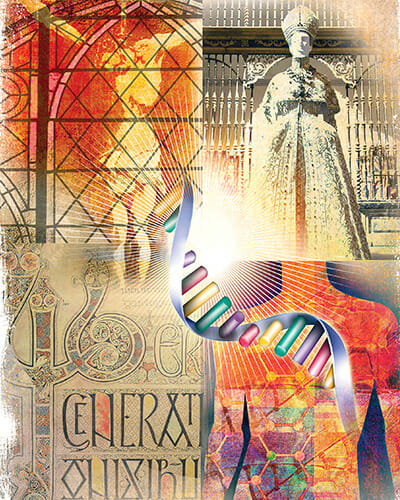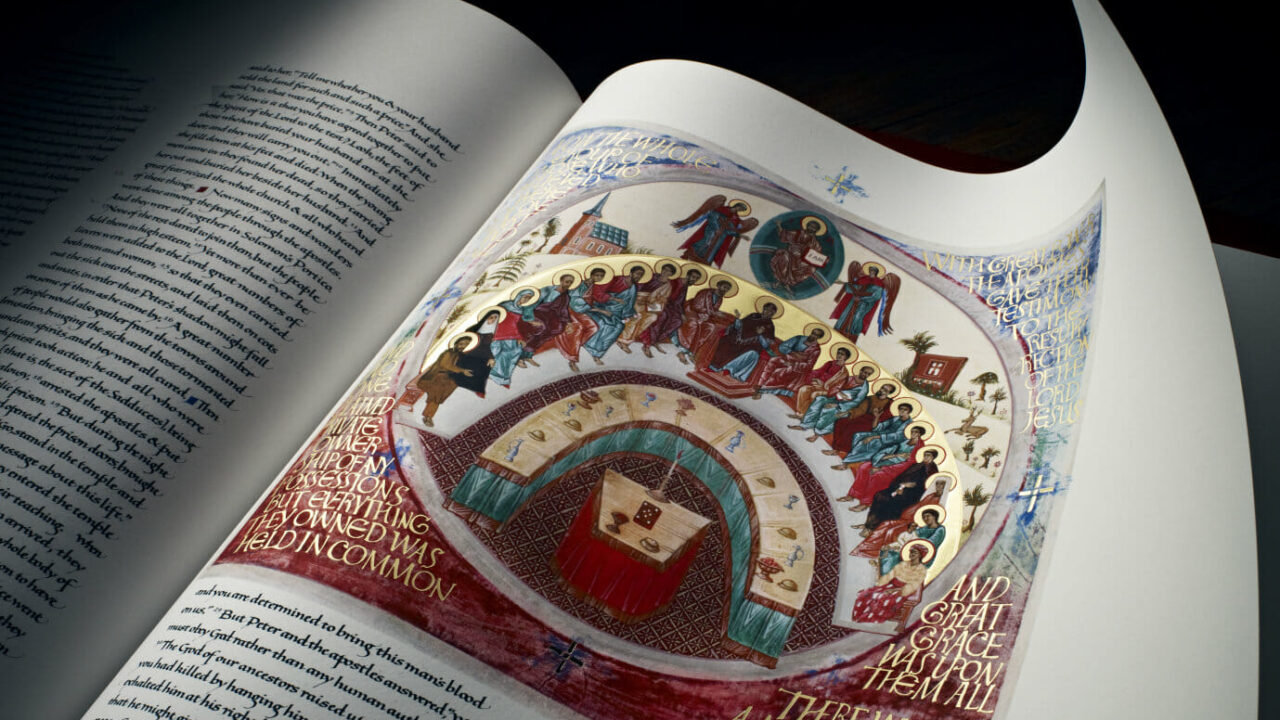The Saint John’s Bible plays a role in many healing environments around the U.S. and beyond, and the impact of its text and illuminations on the spirit and mind can be understood intuitively. But the latest issue of Health Progress, The Journal of the Catholic Health Association of the United States, goes further, with research-based, academic and theological examinations of how the Bible can contribute to “Healing Spaces.”
Introducing the issue’s theme, editor Mary Ann Steiner writes that healing spaces can include “modest clinics that care for trafficked victims, sacred corridors through which patients are wheeled to urgent treatments, private rooms where families wonder what to do next, and quiet nooks that nurses find to relieve the stress and grieve the losses.” Many of these settings can be found within Trinity Health System, and its SVP of mission and ethics, Philip Boyle, serves as a guest co-editor of the issue.

Boyle shared his thoughts with The Scribe last year on how his health system is incorporating the Heritage Edition into its own healing spaces, and expands on that for Health Progress in his own article, “Trinity Health Explores Healing Presence.” In it, Boyle writes that the health system’s acquisition of the Heritage Edition provided a “significant impetus” to examine their healing environment:
“As the volumes of the Bible moved across several sites, we found the response to the Bible from staff and visitors sparked a broad discussion about the place of beauty in healing. The beauty of image and word in The Saint John’s Bible folios almost single-handedly galvanized our commitment to the relationship of art and healing presence. The physical presence of the manuscript in several of the ministries convinced us of the need to systematically explore and make clearer the element of a healing environment as it relates to our mission statement and, more broadly, Catholic identity.
Thus, in 2017 Trinity Health Mission Integration embarked on an initiative to explore the elements that compose a ‘healing environment’ and investigate, in particular, the positive ways to nurture and advance a healing presence.”
Boyle writes that after extensive research by the Trinity Health team, a number of attributes that characterize a healing environment were identified. Among these attributes was beauty, with Boyle noting:
“Environments that bring beauty to patients or those in suffering and pain bring an incarnational presence of the healing God. Perhaps not surprisingly, the arrival of The Saint John’s Bible, containing modern abstract hand-painted images, ignited the spiritual imagination of employees and patients alike to a healing presence. Environments that offer beautiful natural views, art, music, poetry, human touch and the opportunity to spend time with animals, can open the spiritual imagination to healing in a way that allows God’s healing grace to enter.”
He concludes that the health system’s research into what constitutes a healing environment “made it more evident that [it] requires quality clinical care, but also a built environment that includes beauty, meaning and connection to open a person’s spiritual imagination through the senses. Gaining a deeper understanding of this phrase contributes not only to gaining clearer understanding of Catholic identity, but more importantly, to creating a transforming, healing environment for those we serve and those with whom we serve.”
Imagination and Healing
The issue includes an article by Zeni Fox, PhD, professor emerita of Immaculate Conception Seminary at Seton Hall University, further explores “the relationship between healing and the religious imagination.” Fox summarizes the creation of The Saint John’s Bible, along with the methods used and artists involved, and quotes Fr. Michael Patella, who notes that the Bible’s illuminations “are spiritual meditations on a text. It is a very Benedictine approach to Scripture.”
Enjoying this article?
Enter your email to receive new stories from The Saint John’s Bible twice a month.
Subscribe
Fox describes The Saint John’s Bible alongside explorations of other artworks that have provided “entry points” for contemplating healing environments and religion’s role in them, such as the 16th-century “Isenheim Altarpiece” and the 2018 exhibition at the Metropolitan Museum of Art, “Heavenly Bodies: Fashion and the Catholic Imagination.” She cites The Saint John’s Bible illuminations, including those referencing the Hubble telescope and DNA, as examples of “artistic representations from the natural world and contemporary life” that “have the potential to engage the spiritual imagination.”
Fox notes that “The creation of The Saint John’s Bible was the collaborative work of many individuals and groups, linked in their desire to design and execute an artistic work with deep pastoral resonance. The task of creating artistic representations for Catholic health care settings requires exactly this collaboration: seeking themes that will link past and present at the service of healing and finding these themes translated into paintings, sculptures and other visuals that invite contemplation.”
Reflecting on Sacred Art

The magazine also features an essay from Barbara Sutton, director of ministerial formation and field education at Saint John’s School of Theology and Seminary. Sutton directs the Seeing The Word curriculum project for The Saint John’s Bible, and in “‘Holy Seeing’ From the Art of The Saint John’s Bible,” she describes the practice of visio divina and how her work “invites people to see the Scripture with the eye of their heart and to fix their sacred gaze on an illumination of the Bible.”
“Sacred art does not just nurture only the patient,” she writes, “but the patient’s family and friends, doctors and care teams, and all who walk the hospital halls and play important roles during key moments in a person’s healing journey.”
Explaining more about how this nurturing happens, Sutton describes the practice of visio divina with examples of specific illuminations from The Saint John’s Bible, including Creation, The Resurrection, and Woman Caught in Adultery, and the varied interpretations she has personally witnessed while leading others to reflect on them.
“It is when we see with our heart that we can find beauty in everything and see a word dance, even in death and sickness,” she concludes. “Our spiritual senses illuminate the Gospel not only in the Bible alone, but in butterflies, grandmothers, Holy Mother Church, adulterous women, men on high, vibrant fabrics and in our silence.”
Read the full articles and find further explorations of Healing Spaces on the Health Progress website, and click here to listen to interviews with Philip Boyle and Zeni Fox on CHA’s podcast.

